By: Lynne Macleod. Photos: provided by Joe Gros
Lynne Macleod is a BWE level 3 Instructor has been a national champion several times. By also competing at Grand Prix Dressage, Lynne loves to show that Working Equitation (WE) can help improve the dressage skills for both horse and rider. Her two horses, Hermes and Lexus QQ, are both pure Lusitano Geldings.
Hermes is a multi-discipline champion, also holding National British Dressage Inter 1 and PSG titles. Last year the pocket rocket represented Great Britain at the WE World Championships in France. Lexus QQ has stepped up this year to advanced level WE and PSG level dressage.
Working Equitation has many challenges and jumping a small jump is one of them. Lynne Macleod and Hermes at Pickering Grange National 2022.
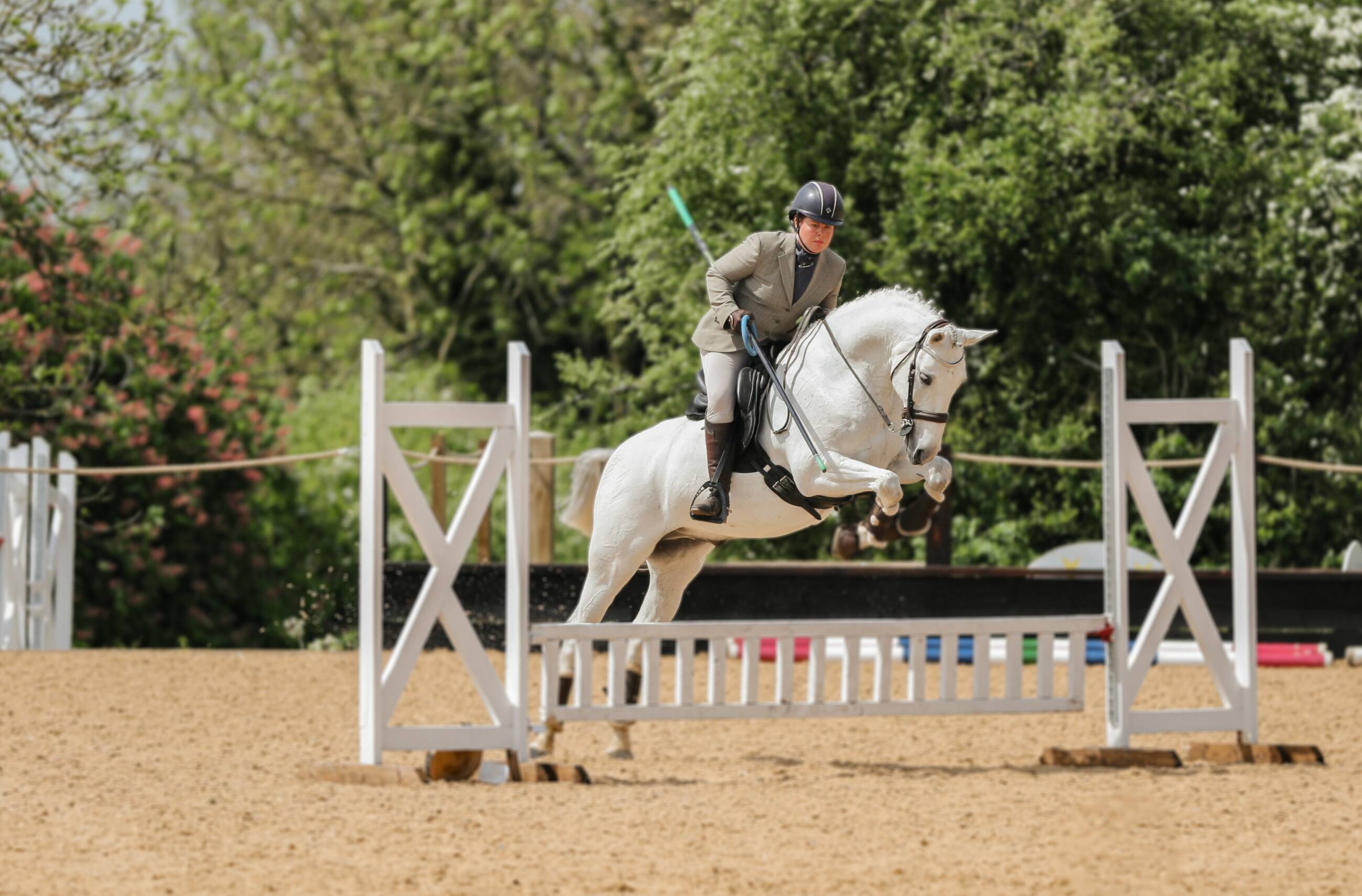


If you want to try
Working equitation is a young sport still and now has a total of 24 nations involved. Competition opportunities are becoming more available, and more and more instructors are becoming qualified to teach.
It really is the most friendly and fun sport which is growing in popularity across the world and specifically here in the UK. To find a wealth of information about clinics competitions, instructors, rules and so on, go to wawe-official.com
If you are interested in joining in or coming along to find out more, with or without your horse, please email me or message me on Facebook.
Horses in Working Equitation needs to be very focussed on their rider for guidance. Here is Lynne Macleod and Brodies Quest on the Bridge at Les Herbiers France 2019.
Lynne Macleod and Hermes chasing cattle as fourth phase.

Second phase
The second phase is ‘Ease of Handling’ - this involves riding a course of numbered obstacles replicating those that may be found when working in the countryside. Riders are given a mark out of 10 for precision, submission and ease of movement for each obstacle. Ideally, judges are looking for collected horses that consistently maintain an even, forward-driving rhythm, move from one obstacle or task to the next demonstrating smooth transitions, and an overall symmetrical performance that really focuses upon the quality of geometry created by horse and rider when completing these patterns.
Third phase includes speed. Here is Lynne Macleod and Lexus QQ doing the Bull at Pickering Grange National 2022.

Lynne Macleod and Hermes at the Festival of the Iberian Horse 2023 showing how to perform the Gate as part of phase two.
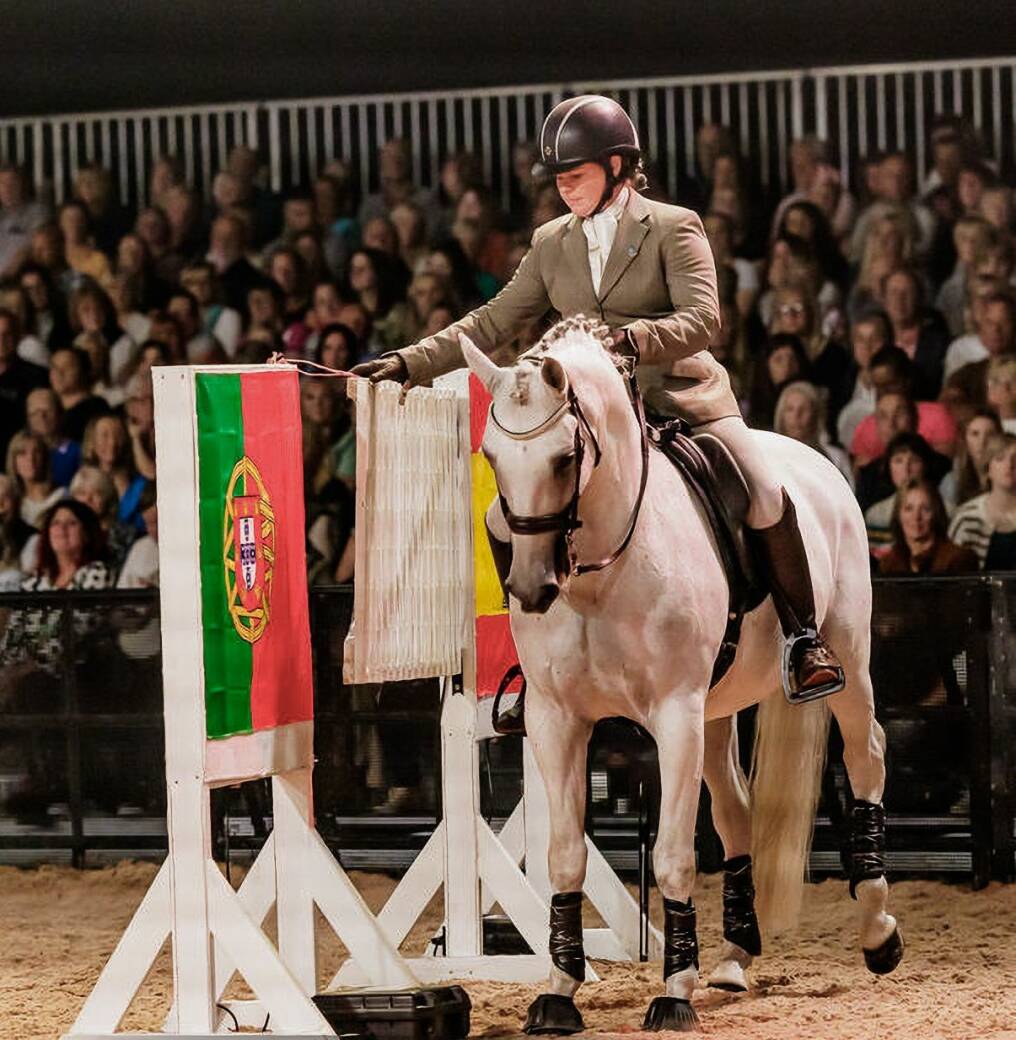
Fourth phase
The fourth and final trial, the cow trial, is included for team competitions. Riders are asked to sort, cut and then herd a specific cow across the line, then as a team get only that cow into a designated pen within the three minutes allotted time This phase is a timed event, with penalties, like the speed round, adding additional time onto a competitor’s time. For example, 10 seconds added if a cow crosses the line if it is not that riders numbered cow. Riders need to communicate, not only with their horses quickly and efficiently, but also with the other members of their team if they are to secure a competitive time during this phase of the competition.
Third phase
The third phase is ‘The speed test’ and it involves some or all of the same obstacles tackled in the ease of handling test but is purely marked on the time it takes for the horse and rider to complete the course. Time faults and bonuses can occur according to specific obstacles. For example, if you collect the ring off the bull, you get five seconds off your total time. But if your horse knocks the sideways pole, you get 10 seconds added to your total time.
First phase
Dressage is the first phase, always in a 20 x 40 meter arena and is similar to normal dressage. Tests can be found for free on the UK Association website abweofficial.co.uk. Competitors must memorize a predetermined pattern that will require manoeuvres based upon the level of difficulty the rider is competing in. Judges score out of 10 for each movement with 10 being excellent and a score of 0 indicating a failure to perform and provide collective marks at the end covering overall impulsion, submission, paces, rider, and presentation.
As the discipline consists of three phases, all horse and rider combinations will naturally find some phases come easier to them than the other and this is one of the great challenges of the sport. Further does the sport provide numerous benefits for the horse. It helps to develop their physical fitness and strength, as well as their coordination and balance. The discipline also requires the horse to be mentally engaged, as they must navigate obstacles with calmness and balance, which can help to reduce boredom and prevent behavioural issues. Additionally, working equitation can help to build the horse's confidence and trust in their rider, as they work together to overcome challenges. It is also a great way to enhance the bond between horse and rider, as it requires teamwork and mutual understanding. The first thing most people say to me is: “My horse would never do that!” It’s great for horses that can be spooky, get distracted easily or sometimes be a little unresponsive to your aids. Using the obstacles to overcome some of these things, not only helps your horse understand the obstacles, but helps set them up to deal with other problems they may face in the future and in general life situations.
What to wear
For competitions correct and smart turnout is important and there is a mark for this. The correct turn out is different for each country so do check your countries rules. It is normally the traditional riding attire, for example in the UK we use English hunting dress, Tweed jackets, cream breeches, the horse plaited and a saddle shaped numnah in a muted colour to compliment the horse. The tack has to stay the same for all phases, but you can add boots after dressage for the other phases if you wish.
What is the format
Working Equitation competitions usually include three phases:
Dressage
Ease of Handling obstacle course
Speed obstacle course
and, at international level, Team Cattle Penning is introduced as a fourth phase
At the highest levels, flying changes and canter pirouettes are required, but there are many levels, so it is suitable for riders of all ages and abilities and horses at any level of training. Everything can be done in walk or trot or even trained in hand to begin with.
Working Equitation is an exciting new international discipline currently sweeping across the equestrian world. Since the first European Championship in 1996, it has become well-established throughout Europe, Brazil, Mexico, Columbia, USA, Great Britain, Canada, Australia and New Zealand.
It originated in Portugal and Spain and combines the equitation practices of a variety of cultures and locales with the goal of promoting a range of techniques for using the working horse for agricultural reasons, working on farms, ranches, and with livestock.
Working Equitation is a real test of the horses’ temperament and training, the rider's skill and ability and of course the relationship between horse and rider. It combines dressage with obstacles; the ability to cross different terrain, open gates, rein back, stand quietly, pick things up and carry them, manoeuvre in tight spaces and listen to the rider, no matter what difficulties they may face.
The sport is a highly refined and sophisticated demonstration of these activities, with the added required qualities of elegance and speed of execution.
Working Equitation is suited to all riders
Having tried most disciplines over the years the main thing I love about the sport is its versatility. Whether you are aiming for competitions or just something new to bring variety to your schooling at home, it is super training and has a multitude of benefits for all levels of horses and riders. You really do not need the next Valegro or Big Star to do well either! The sport is the ultimate outcome of the development of the horse as a working animal.
It is often associated with the Iberian breeds, such as P.R.E and Lusitanos, but is open and suitable to every breed of horse.
Here in the UK, we see a huge variety of breeds competing and at the World Championships recently there was a real mixture from Lusitanos, PRE, to Warmbloods, Haflingers, Fjords and in the UK we have Quarter horses, Islandic horses, Highland ponies, Dales, Arabs, Connemaras, Welsh and more.
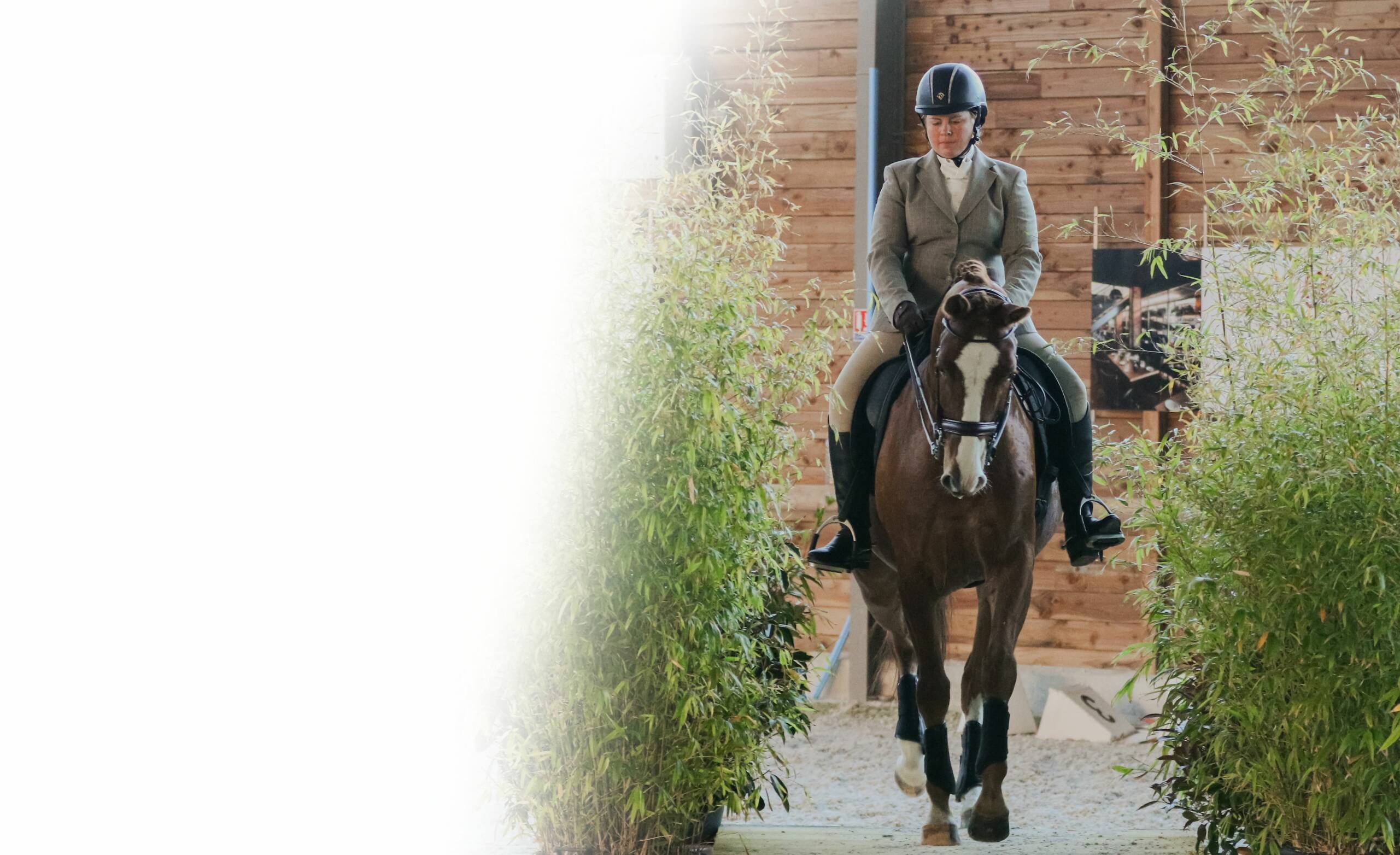
By: Lynne Macleod. Photos: provided by Joe Gros
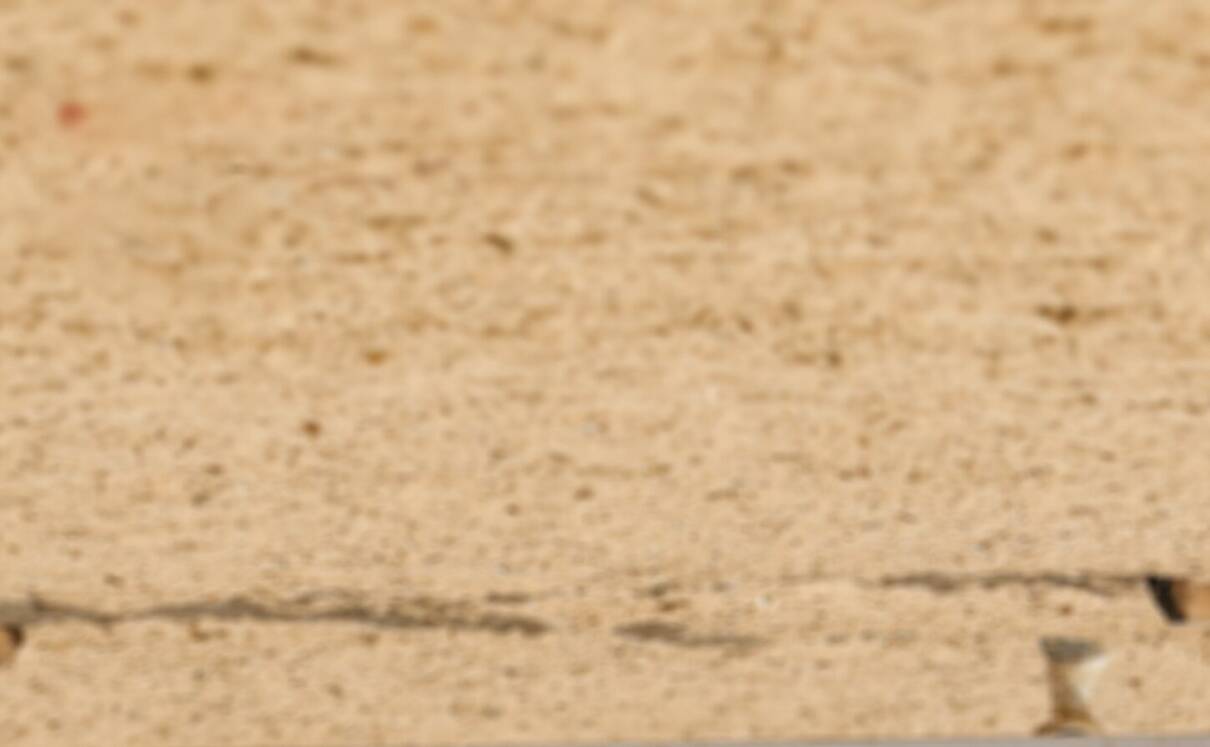

Lynne Macleod is a BWE level 3 Instructor has been a national champion several times. By also competing at Grand Prix Dressage, Lynne loves to show that Working Equitation (WE) can help improve the dressage skills for both horse and rider. Her two horses, Hermes and Lexus QQ, are both pure Lusitano Geldings.
Hermes is a multi-discipline champion, also holding National British Dressage Inter 1 and PSG titles. Last year the pocket rocket represented Great Britain at the WE World Championships in France. Lexus QQ has stepped up this year to advanced level WE and PSG level dressage.


Fourth phase
The fourth and final trial, the cow trial, is included for team competitions. Riders are asked to sort, cut and then herd a specific cow across the line, then as a team get only that cow into a designated pen within the three minutes allotted time This phase is a timed event, with penalties, like the speed round, adding additional time onto a competitor’s time. For example, 10 seconds added if a cow crosses the line if it is not that riders numbered cow. Riders need to communicate, not only with their horses quickly and efficiently, but also with the other members of their team if they are to secure a competitive time during this phase of the competition.
Second phase
The second phase is ‘Ease of Handling’ - this involves riding a course of numbered obstacles replicating those that may be found when working in the countryside. Riders are given a mark out of 10 for precision, submission and ease of movement for each obstacle. Ideally, judges are looking for collected horses that consistently maintain an even, forward-driving rhythm, move from one obstacle or task to the next demonstrating smooth transitions, and an overall symmetrical performance that really focuses upon the quality of geometry created by horse and rider when completing these patterns.
Horses in Working Equitation needs to be very focussed on their rider for guidance. Here is Lynne Macleod and Brodies Quest on the Bridge at Les Herbiers France 2019.
If you want to try
Working equitation is a young sport still and now has a total of 24 nations involved. Competition opportunities are becoming more available, and more and more instructors are becoming qualified to teach.
It really is the most friendly and fun sport which is growing in popularity across the world and specifically here in the UK. To find a wealth of information about clinics competitions, instructors, rules and so on, go to wawe-official.com
If you are interested in joining in or coming along to find out more, with or without your horse, please email me or message me on Facebook.
Lynne Macleod and Hermes chasing cattle as fourth phase.
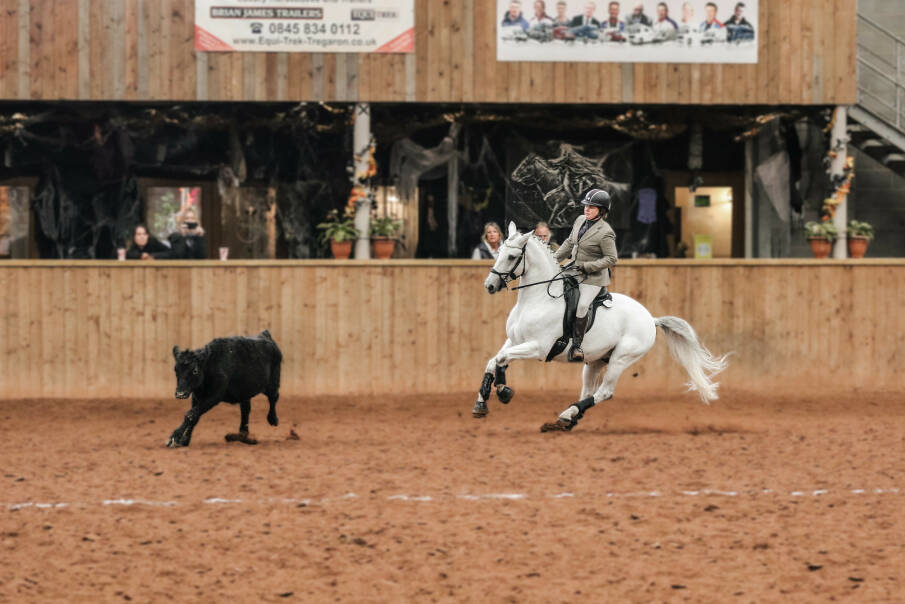
Third phase includes speed. Here is Lynne Macleod and Lexus QQ doing the Bull at Pickering Grange National 2022.
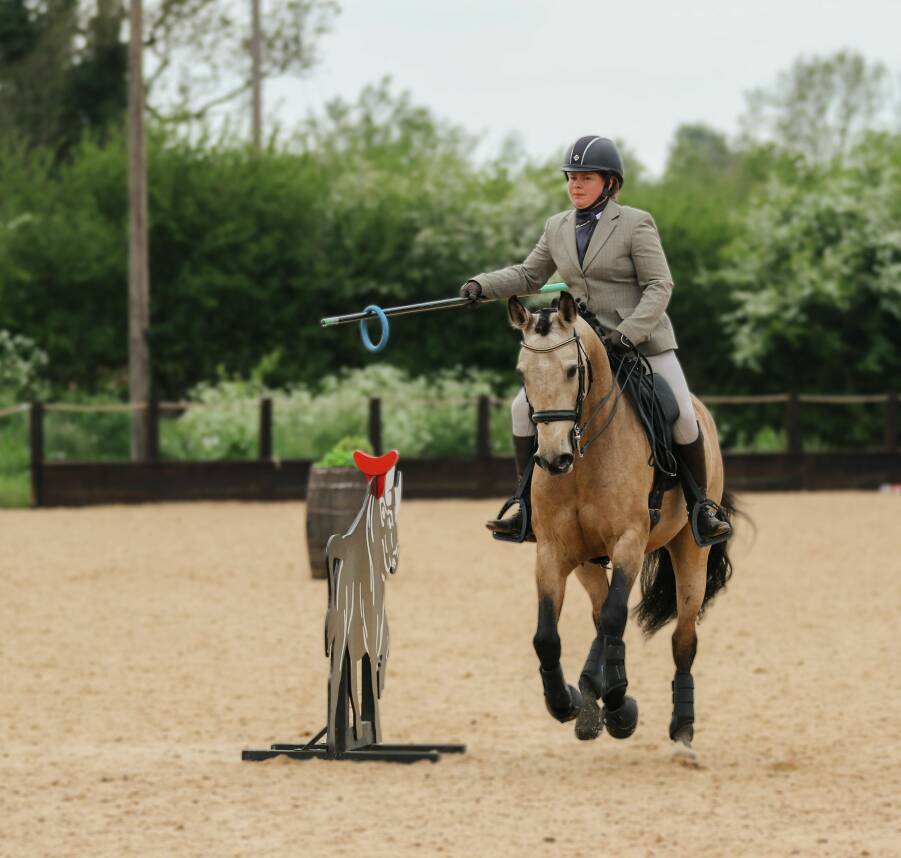
Lynne Macleod and Hermes at the Festival of the Iberian Horse 2023 showing how to perform the Gate as part of phase two.

Third phase
The third phase is ‘The speed test’ and it involves some or all of the same obstacles tackled in the ease of handling test but is purely marked on the time it takes for the horse and rider to complete the course. Time faults and bonuses can occur according to specific obstacles. For example, if you collect the ring off the bull, you get five seconds off your total time. But if your horse knocks the sideways pole, you get 10 seconds added to your total time.
First phase
Dressage is the first phase, always in a 20 x 40 meter arena and is similar to normal dressage. Tests can be found for free on the UK Association website abweofficial.co.uk. Competitors must memorize a predetermined pattern that will require manoeuvres based upon the level of difficulty the rider is competing in. Judges score out of 10 for each movement with 10 being excellent and a score of 0 indicating a failure to perform and provide collective marks at the end covering overall impulsion, submission, paces, rider, and presentation.
As the discipline consists of three phases, all horse and rider combinations will naturally find some phases come easier to them than the other and this is one of the great challenges of the sport. Further does the sport provide numerous benefits for the horse. It helps to develop their physical fitness and strength, as well as their coordination and balance. The discipline also requires the horse to be mentally engaged, as they must navigate obstacles with calmness and balance, which can help to reduce boredom and prevent behavioural issues. Additionally, working equitation can help to build the horse's confidence and trust in their rider, as they work together to overcome challenges. It is also a great way to enhance the bond between horse and rider, as it requires teamwork and mutual understanding. The first thing most people say to me is “My horse would never do that!” It’s great for horses that can be spooky, get distracted easily or sometimes be a little unresponsive to your aids. Using the obstacles to overcome some of these things, not only helps your horse understand the obstacles, but helps set them up to deal with other problems they may face in the future and in general life situations.
What to wear
For competitions correct and smart turnout is important and there is a mark for this. The correct turn out is different for each country so do check your countries rules. It is normally the traditional riding attire, for example in the UK we use English hunting dress, Tweed jackets cream breeches, horses plaited and a saddle shaped numnah in a muted colour to compliment the horse. The tack has to stay the same for all phases, but you can add boots after dressage for the other phases if you wish.
What is the format
Working Equitation competitions usually include three phases:
Dressage
Ease of Handling obstacle course
Speed obstacle course
and, at international level, Team Cattle Penning is introduced as a fourth phase
At the highest levels, flying changes and canter pirouettes are required, but there are many levels, so it is suitable for riders of all ages and abilities and horses at any level of training. Everything can be done in walk or trot or even trained in hand to begin with.
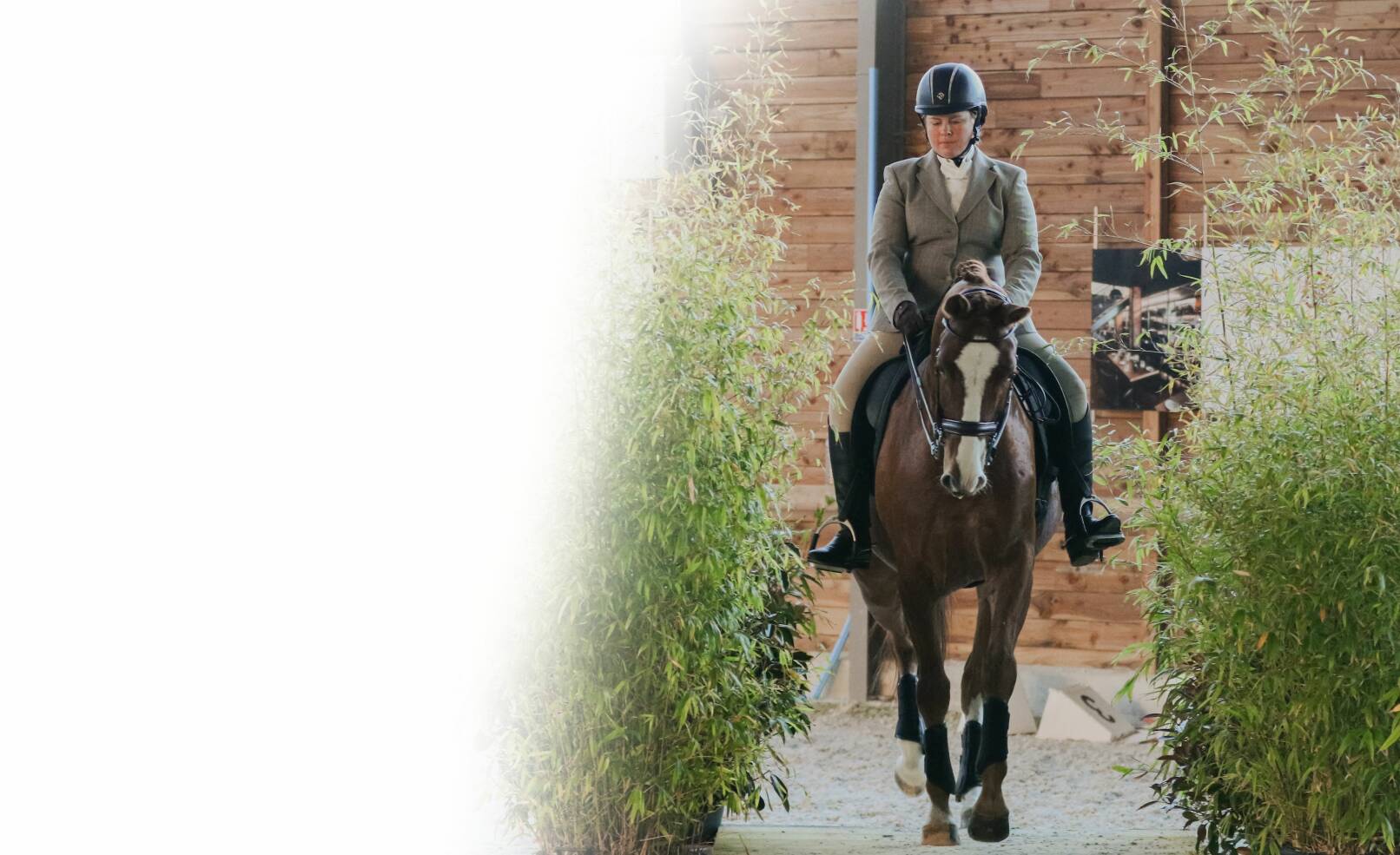
Working Equitation is an exciting new international discipline currently sweeping across the equestrian world. Since the first European Championship in 1996, it has become well-established throughout Europe, Brazil, Mexico, Columbia, USA, Great Britain, Canada, Australia and New Zealand.
It originated in Portugal and Spain and combines the equitation practices of a variety of cultures and locales with the goal of promoting a range of techniques for using the working horse for agricultural reasons, working on farms, ranches, and with livestock.
Working Equitation is a real test of the horses’ temperament and training, the rider's skill and ability and of course the relationship between horse and rider. It combines dressage with obstacles; the ability to cross different terrain, open gates, rein back, stand quietly, pick things up and carry them, manoeuvre in tight spaces and listen to the rider, no matter what difficulties they may face.
The sport is a highly refined and sophisticated demonstration of these activities, with the added required qualities of elegance and speed of execution.
Working Equitation is suited to all riders
Having tried most disciplines over the years the main thing I love about the sport is its versatility. Whether you are aiming for competitions or just something new to bring variety to your schooling at home, it is super training and has a multitude of benefits for all levels of horses and riders. You really do not need the next Valegro or Big Star to do well either! The sport is the ultimate outcome of the development of the horse as a working animal.
It is often associated with the Iberian breeds, such as P.R.E and Lusitanos, but is open and suitable to every breed of horse.
Here in the UK, we see a huge variety of breeds competing and at the World Championships recently there was a real mixture from Lusitanos, PRE, to Warmbloods, Haflingers, Fjords and in the UK we have Quarter horses, Islandic horses, Highland ponies, Dales, Arabs, Connemaras, Welsh and more.